New in May 2016, Sony Cyber-shot DSC-RX10 III (buy at Amazon) was my ultimate travel camera in 2016–17 (antiquated by the RX10 IV in 2018). It features a bright f/2.4-4 lens with incredible 25x zoom, sharp across the frame throughout its remarkable 24-600mm equivalent range, well into birding territory. I no longer need to carry a pocket camera for improving close-focus shots, as RX10 already has a 1”-Type sensor. With deeper depth of field than APS-C or larger-sensor cameras for a given f-stop, it enhances details from close flower shots to distant bird feathers at 600mm equivalent telephoto. This all-in-one marvel is also my top pick for portable wildlife telephoto. The chunky RX10 III weighs just 37 ounces (including battery & card; plus adding 5 oz for strap, lens filter, cap & hood makes 42 oz). RX10 III is the world’s most versatile camera for on-the-go outdoor photographers. Further below, compare with rivals and learn about important hidden settings and accessories.
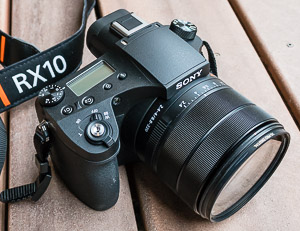
In a breakthrough for travel photographers, Sony has more than doubled my former zoom range while improving image quality. The professionally-sharp, bright 25x zoom of RX10 III resoundingly beats the resolution of my previous favorite Sony 11x zoom lens SEL18200 on flagship APS-C Sony A6300 anywhere above 90mm+ equivalent telephoto, even as high as ISO 6400. To my delight, RX10’s faster, larger-diameter lens (72mm filter size) plus backside illumination (BSI) sensor technology together magically compensate for the sensor size difference. At wider angles, 27-80mm equivalent, both capture similar quality in bright outdoor light. Advantageously, RX10 stretches to a wide view of 24mm equivalent. In dim/indoor light, A6300’s larger sensor can sometimes resolve more detail than RX10III, but not consistently in my real world comparisons using SEL18200 and SEL1670Z lenses. Impressively, Sony claims SteadyShot stabilization of up to 4.5 stops of benefit (in terms of slower shutter speed handheld) for this model DSC-RX10M3.
For me, RX10 III’s only weakness is frequent failure to lock focus on the far telephoto end 400-600mm equivalent in dim light or on low-contrast subjects, fixed by upgrading to Sony RX10 IV (price at Amazon) (or by using Manual Focus, or by using rival Panasonic FZ2500 compared below).
TIP: Despite Sony’s claim of “dust and moisture-resistant” body, DON’T EXPOSE YOUR CAMERA TO RAIN (even if immediately wiped off), as wind-driven droplets killed my RX10 III. Despite its weather sealing keeping dust and condensation out of the lens throughout 16 months, one fateful rainstorm shorted-out its focus and LCD (sadly outside of its 1-year Sony Warranty). Rather than risking an estimated $656 repair (whose 90-day guarantee is voided by “liquid damage”), I bought a new RX10 III (to complete my UK photo shoot) then upgraded to RX10 IV.
Unprecedented versatility with publishable image quality have made Sony RX10 III my main travel camera for 2016-2017.
Three extracts from the edges and center of this Chilean Flamingo image show the crisp 600mm-equivalent telephoto reach of Sony RX10 III:
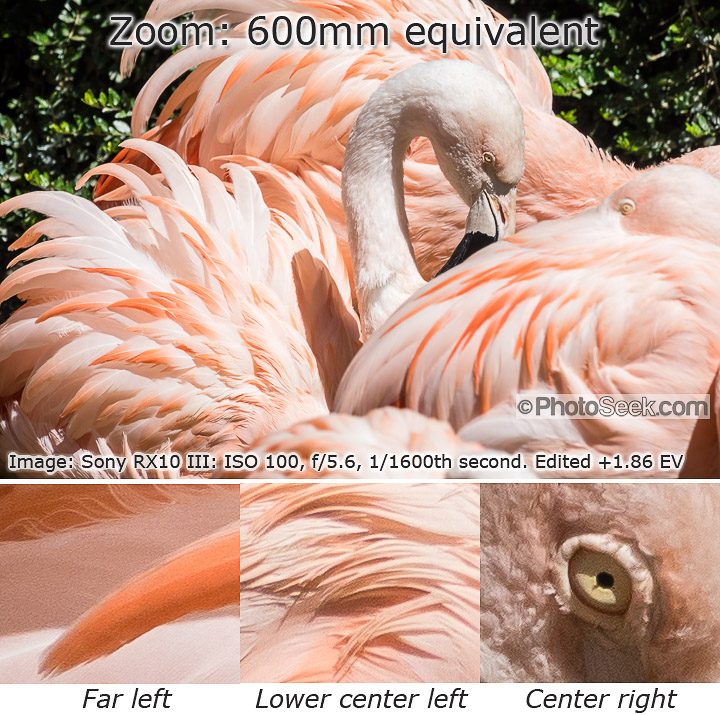
Recommended accessories for Sony RX10 III & IV:
- Sony PCK-LM15 Semi Hard Protective LCD Cover preserves resale value. (Avoid JJC brand LCP-RX100 which creates an unsightly bubble in contact with the LCD.)
- Wasabi Power NP-FW50 (1300mAh) batteries for Sony extend shooting time on the go.
- SanDisk Extreme PRO 128GB UHS-I/U3 SDXC Flash Memory Card (Amazon) fits weeks of shooting.
- B+W 72mm XS-Pro Clear MRC-Nano 007M Filter protects lens from scratches & catastrophic drops.
More details:
In 2016, Tom ranked the top travel cameras (best first and smallest last):
[but see Tom’s Camera Reviews page for the latest rankings]
- Sony RX10 III (May 2016, 37 oz, 25x zoom 24-600mm f/2.4-4): the best travel camera of 2016 handily beats its closest rivals having 1” BSI sensor. It has a nice tilting LCD, but no touchscreen.
- Panasonic FZ2500 (December 2016, 33 oz, 20x zoom 24-480mm f/2.8–4.5): costs 25% less, adds a fully articulated LCD with touchscreen, increases viewfinder magnification (EVF 0.74x versus 0.7x), autofocuses faster, has better menus and improves video specs (ND filter, Cine/UHD 4K), in comparison to Sony RX10 III. But FZ2500’s lens collects a half stop less light, slightly lowering image quality; its telephoto doesn’t reach long enough for birders; and its CIPA battery life of 350 shots is shorter than RX10III’s 420 shots. (FZ2500 is FZ2000 in some markets.)
- Panasonic FZ1000 (2014, 29 oz, 16x zoom 25-400mm f/2.8-4.0): best price value (costs half of RX10 III). Adds fully-articulated LCD and autofocus for action & sports is a bit faster than RX10 III.
- Pocketable: Panasonic ZS100 (price at Amazon) (2016, 11 oz, 10x zoom 25-250mm equivalent f/2.8-5.9): Read my ZS100 review. ZS100 introduces the first pocketable 10x zoom on a 1-inch-Type sensor, capturing close macro at more zoom settings and enormously extending optical telephoto reach beyond my 3x-zoom Sony RX100 (read my 2012-15 review). Anywhere from 3x-10x on Panasonic ZS100 beats digital cropping of rival Sony RX100 (which stops at 70mm equivalent in versions III and IV).
- Half-price pocketable: Panasonic ZS50 (2015, 9 oz, 30x zoom 24–720mm f/3.3–6.4, 12 mp) is a nice little camera with a rare viewfinder and a small 1/2.3″ sensor that still beats smartphone quality. (TZ70 outside of North America.)
Sony RX10 III beats the following midsize rivals for versatile lightweight travel:
- APS-C flagship Sony Alpha A6300 (2016, 33 oz = 14 oz body + 11x zoom 27-300mm equivalent f/3.5-6.3 lens): its interchangeable-lens capability is made redundant by RX10’s sharp and bright 25x zoom. See my side-by-side test images further below.
- Canon PowerShot G3 X camera
(2015, 26 oz, 25x zoom, 20mp) has 24-600mm equivalent f/2.8-5.6 lens (which is neither as bright nor as sharp as Sony RX10 III). The G3 X buys you lighter travel weight, but you must separately add a pricey $240 viewfinder. Also its older, poorer 1″ sensor is a stop or two worse at ISO 800+ in terms of noise compared to FZ1000 or RX10.
- The following 44-ounce Nikon 1 interchangeable lens system of 2014 is now outdated:
- Nikon 1 V3 camera (2014, 14-oz body, 18mp) mounted with Nikkor VR 70-300mm CX format lens (19 oz) has a sharp 189-810mm equivalent zoom but relatively slow f/4.5-5.6 aperture. Capturing normal angles of view requires inconvenient swapping of the 70-300mm lens, such as to 10-100mm CX-format lens (27-270mm equiv, 10.5 oz) for Nikon 1.
- With fewer megapixels (18mp versus 20mp) shot on a poorer, noisier sensor (at least 2 stops noisier at ISO 400+) using a slower lens, Nikon 1 V3 cannot beat Sony RX10 III.
- In February 2017, Nikon cancelled its proposed DL camera
line of premium compact cameras (DL 18-50, DL 24-85 and DL 24-500 announced in 2016). Nikon DL24-500 would have had a relatively slow f/2.8-5.6 lens (28 oz, 21x zoom, 21mp).
What do I know?
For lightweight travel gear capturing publishable images, I’m not tied to any one system or brand. Instead, I prefer upgrading to the latest, best tool for the job (then selling the old gear locally via Craigslist, in-person for cash). I’ve enjoyed the 24mp APS-C sensor in Sony NEX-7 from 2012-2016 and successor A6300 using Sony’s 18-200mm SteadyShot lens (27-300mm equivalent). Before that, Nikon gear served me well over 11 years (see Tom’s gear history), such as Nikon D5000 APS-C with 18-200mm VR II lens. I began photography in 1978−97 with the classic Olympus OM-1N 35mm-film camera. But switching to digital Canon PowerShot cameras from 2003-07 gave me instant feedback and more freedom from the tripod. Now as of 2016, the 1-inch-sensor Sony RX10 III preserves publishable image quality while radically extending zoom range to 25x. The proof is in the pudding: check out my portfolio.
What do others say? Reviewer Ken Rockwell says the RX10 III is “superb for sports; it really does lock-on to faces and track them as they run down the field, and its non-rolling electronic shutter lets it run silently at 5 real frames per second as it tracks everything…and the RX10 III is astonishing in how much it does so well.” Be sure to turn on Eye AF for instant focus on humans.

RX10 III rivals a sharp 4x zoom F4 lens on APS-C sensor
According to my side-by-side testing, Sony’s RX10 III camera has a remarkable equality to the flagship APS-C Sony A6300 in dim light, due to RX10 III’s more-efficient BSI sensor design plus its large diameter lens of 72mm gathering more light (versus the much smaller 55mm filter size on the pricey SEL1670Z comparison lens).
Details: In my June 2016 side-by-side tests in bright sunlight, Sony’s sharp F4 16-70mm 4x zoom lens (SEL1670Z, 24-105mm equivalent) mounted on A6300 can resolve linear details only up to 5% better than my Sony RX10 III camera at wide angles of view. SEL1670Z is also sharper for macro in dim or bright light (using closest focus at around 45mm equivalent). But in dim light or at 75-105mm equivalent telephoto, the two systems on average capture equally sharp images, despite the sensor size difference (APS-C versus 1-inch-type).
These field tests demote the APS-C flagship A6300, making it no longer my top travel camera. The gain is nearly insignificant for A6300 to make at most 5% wider or taller prints compared to Sony RX10 III; and A6300’s advantage requires direct sunlight at wide angles of view, or macro. From 75-105mm equivalent in most lighting situations or in dim indoor light across its range (except 45mm macro), SEL1670Z is equaled or beaten by RX10 III in half of my hand-held shots at optimally-sharp apertures, with image stabilization turned on.
You must inconveniently interchange a much heavier, pricier set of lenses on A6300 to rival the quality of RX10 III’s sharp 25x F4 zoom.
My Sony A6300 (read Tom’s review) can still be useful as a lightweight camera for action and indoor event photography (such as weddings) at wider angles of view, such as at 24-105mm equivalent using Sony’s 16-70mm F4 SEL1670Z lens. (The SEL1670Z lens has good macro when set at 30mm, which is 45mm-equivalent in terms of full-frame’s angle of view.) The A6300 has a bit quicker autofocus such as for tracking of moving subjects, which I rarely use. But future upgrades to Sony’s A6300 will require new advances, such as more megapixels and the creation of backside illumination (BSI) sensors at APS-C size, in order to gain a clearer advantage over the groundbreaking Sony RX10 III.
How does Sony RX10 III compare to full-frame?
For a significant jump up in quality, night photographers and big-print professionals can consider using fast lenses on Sony a7R II (price at Amazon) (2015, 22 oz body), a big 42-megapixel full-frame mirrorless camera, featuring the world’s first 35mm-size BSI CMOS sensor, plus a 5-axis image stabilization built into the body, hybrid autofocus, and 4K video, good for capturing the northern lights or indoor action.
But for me, full-frame systems are too bulky and expensive for travel, especially in terms of zoom range. If money is no object, using Sony’s 10x zoom FE 24-240mm f/3.5-6.3 lens (28 oz) on A7 IIR’s 42mp sensor (50 oz total camera+lens) should buy quality at wide angles better than RX10III’s smaller 20mp sensor (37 oz). But RX10III’s f/4 quality should beat cropping down the 42mp to reach the 500-600mm equivalent necessary for wildlife and bird photos. Realistically, A7 IIR’s incredible sensor so greatly exceeds the quality of the FE 24-240mm lens that only sharper, faster lenses should be considered. In comparison, RX10 III is much more portable (37 oz versus 50+ oz) and its 20 megapixels are plenty for my professional publishing needs.
In historical perspective, the Sony RX10III makes prints far bigger than my full-frame 35mm film cameras used 1978-2004.
Compact 25x zoom RX10 III beats APS-C travel systems using 11x to 19x
In 90% of my test shots (see examples below), the RX10 III beat image quality from the much bigger sensor (APS-C) in Sony’s flagship A6300 mounted with 11x Sony SEL18200 silver lens (27-300mm equivalent). Similarly, I expect RX10 III should also beat the 10x zoom Sony FE 24-240mm f/3.5-6.3 OSS E-mount SEL24240 lens (see at Amazon) on A6300. RX10 III should likewise outperform Tamron’s 19x zoom 16-300mm equivalent lens and best all current 11x-17x zoom lenses by Nikon, Canon and Sigma (when mounted on APS-C systems of up to 24 megapixels), based upon how similarly SEL18200 compares to them in reviews at SLRgear.com, DxOMark.com, and others.
According to my practical field tests, RX10 III excels at 24-27mm wide angle, at stunning telephoto from 80-600mm equivalent (well into the range of wildlife/bird photography), and at close focus (best macro enlargement at 50mm equivalent albeit an inch from the lens, and with nice 29″ working distance at 600mm using f/5.6). No rival comes close in its weight class.
In comparison, Sony’s flagship APS-C camera, the A6300 mounted with my trusty 11x travel zoom (silver model SEL18200 with relatively slow aperture f/3.5-6.3) resolved slightly more image details only within a sweet spot from 30-60mm equivalent (where 24 megapixels could beat RX10’s 20mp), especially at ISO 640+. But to my delight throughout 90-600mm equivalent, the RX10 III consistently beat the SEL18200 lens through ISO 6400, due to brighter lens, superior optics and BSI technology, a stellar performance from a sensor 3 times smaller!
Note: Sony’s 11x SEL18200 lens suffers substantial bloating from barrel distortion at its widest angles of view (27-42mm equivalent) and is squeezed by pincushion distortion at 50-150mm equivalent (which I corrected using Adobe Lightroom’s Enable Lens Profile Corrections in the examples below). In contrast, the RX10 III captures crisp rectilinear lines, great for architecture photography — thankfully recorded with distortions and chromatic aberrations all auto-corrected by default using a “Built-in Lens Profile” in both JPEG and raw, straight out of the camera!
Despite superior autofocus performance by Sony Alpha a6300 (price at Amazon), especially in dim indoor light, its success rate capturing detailed images suffers when using Sony SEL18200 lens, which is sharp at center but rapidly fuzzier towards the edges, especially at 100-300mm equiv.
To rival the crisp 25x zoom of 37-ounce RX10 III, an APS-C-sensor camera would need to interchange lenses on a pricier system weighing more than 55-66 ounces − inconvenient for travel. For example, Sony’s 14-ounce A6300 body now begs for the following bulkier, pricier system to replace the Sony 11x SEL18200 lens:
- Sony E-mount 16-70mm F4 Vario-Tessar T ZA OSS SEL1670Z lens (Amazon)
(2013, 11 oz).
- Sony FE 70-300mm F4.5-5.6 G OSS SEL70300G lens
(2016, 30 oz).
- Sony DSC-RX100 (IV, III, II, or I)
pocket camera for decent macro.
Critical photo comparisons of Sony RX10 III versus A6300 with SEL18200
For realistic comparison, test images on this page have been shot as raw files, corrected, and optimized. Sony RX10 III images shown at 100% pixel view have been upscaled from 20 to 24 megapixels to line up against the Sony A6300 images shot on SEL18200 lens (for normalization as in a same-size print comparison). Active animals were shot at 1/500 second in Shutter Priority mode to freeze motion blur. Static subjects were shot near camera-equivalent apertures to equalize depth of field (for example, f/4 on 1” sensor has same pupil diameter as f/7.1 on APS-C, as calculated from their relative diagonal crop factor of 1.77). ISO was shot on Auto then reported for each shot.
In the following comparison at 340mm equivalent, the RX10 III captures superior sharpness in the bird’s feather details:
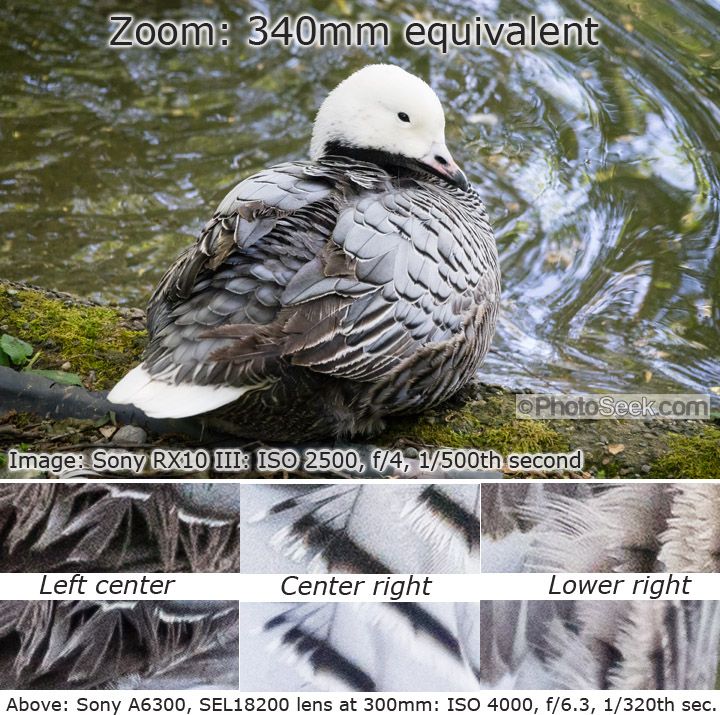
In the following dim indoor image shot at high ISO 6400 without flash, the superior optics of Sony RX10 III clearly beat a Sony A6300 with SEL18200 lens, both zoomed to 195mm equivalent:
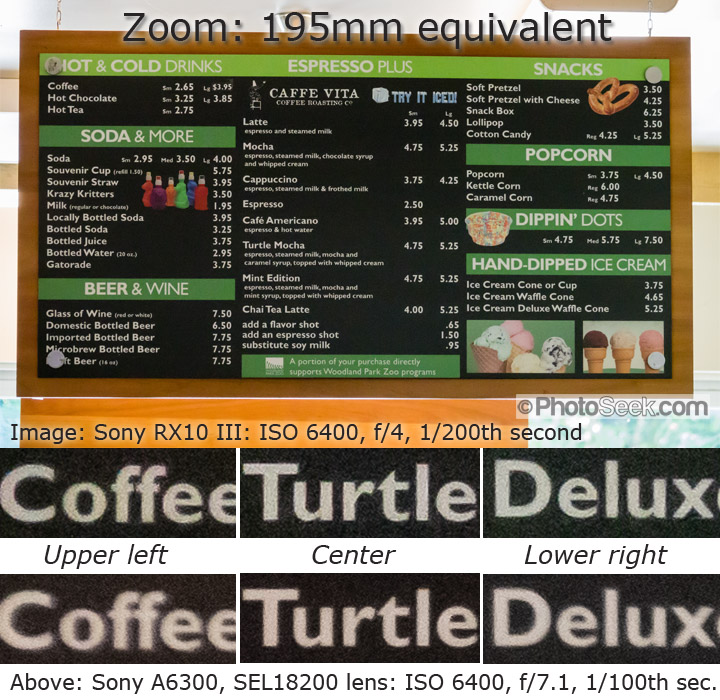
In the following image at 27mm equivalent at base ISO 100, the RX10 III wins by a hair over A6300 with SEL18200:
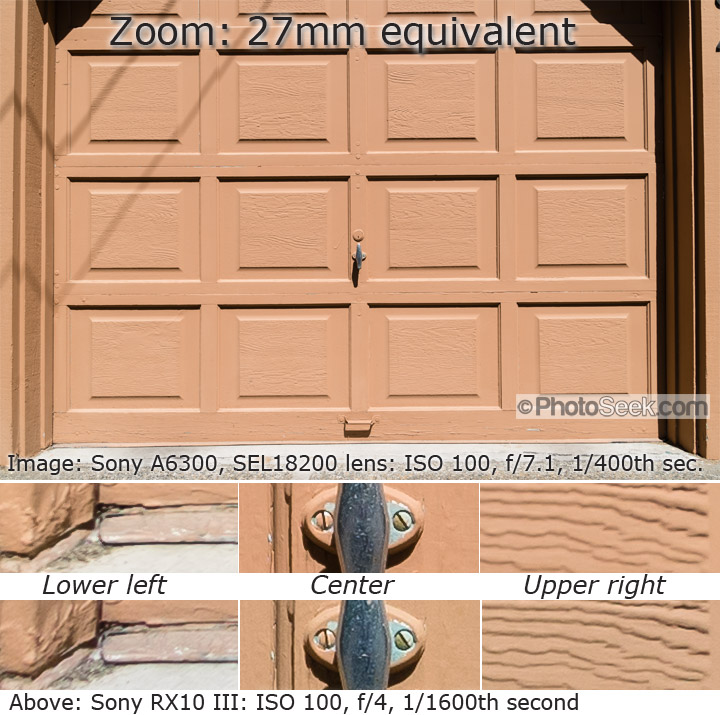
Other testing shows that after correcting for distortion, the Sony A6300 with 11x SEL18200 lens can only beat RX10 III in dim lighting within a sweet spot from 30-60mm equivalent (assisted by its 3-times-larger sensor). But in bright outdoors, you see little difference at wide angles of view. In effect, the A6300 begs for a sharper lens, such as Sony 16-70mm F4 or a set of prime lenses which require interchanging (too inconvenient for my travel photography). Comparatively speaking, A6300 with 11x zoom now lacks sufficient quality and versatility for a given travel weight. For my typical outdoor nature photography on the go, RX10 III captures superior edge-to-edge details at more zoom settings.
Recommended settings: secrets of the Sony RX10 III
- Through most of its 25x zoom range, RX10 III is sharpest when shot about f/4 aperture; but f/5.6 is sharpest at 500-600mm equivalent. In effect, these optimal f-stops give you the best balance between diffraction (through smallest apertures) versus chromatic aberrations (possible in all cameras at brightest openings; luckily hardly noticeable in RX10 III due to automatic in-camera corrections before writing JPEG and raw files to the memory card).
- Stopping down to f/16 aperture, RX10III creates a wonderful starburst effect emanating from intense pinpoints of light such as the sun, lightbulbs, etc (see starburst photo further above). WARNING: as on most cameras, f/16 looks MUCH SOFTER in focus when analyzed at 100% pixel view, nearly halving the resolution compared to f/5.6 or brighter apertures, due to diffraction through the tiny f/16 hole. (At all apertures brighter than f/16, the starburst is NOT created, such as at f/2.4 to f/4, where rounded blades smooth the opening for more attractive bokeh, the appearance of the out-of-focus areas.) Using Adobe Lightroom CC, I like to stitch panoramas where the shot with the sun has an f/16 starburst, but the remaining combined shots without the starburst use the much sharper f/4 or f/5.6. For sharper starburst images at f/4 to f/5.6, you may want to use a starburst filter (screw-on or handheld square glass) instead of suffering the detrimental effects of f/16, unless your artistic intent is soft-focus.
- For sharper hand-held shots at 600mm maximum telephoto, leave Image Stabilization ON and use 1/100th second shutter speed or faster.
- Zoom Assist: To more easily locate birds or small subjects at 500-600mm telephoto (to see outside of that narrow angle of view), reassign the Focus Hold button (on the base of the lens, or use another button of your choice) to Zoom Assist. When pressed, the Zoom Assist button quickly widens the angle of view to allow re-centering upon a bird; then you can pan to follow the bird’s motion, then release Zoom Assist to restore your original narrow angle of view. Once focus is locked onto a moving subject, take the shot as soon as possible, or half press again to refocus. For isolated subjects, I prefer Expand Flexible Spot, using Single Autofocus, because Continuous Auto Focus can be problematic on any camera (unless fast-paced action requires Continuous AF, which may risk unwanted slow AF racking or hunting). Half press to lock focus on a high contrast edge of the subject, recompose, then fully click the shutter release.
- Increase zoom racking speed: from 24 to 600mm in just 2 seconds, by setting Zoom Speed = “Fast” in Menu > Settings Tab 2 > Set #3. That’s twice as fast as the 4-second Normal default. I mostly prefer Normal, for finer framing control, except for fleeting wildlife or sports. The Zoom Speeds of Fast and Normal apply to still shots; but Movie recording mode thankfully automatically invokes a slower, virtually silent zoom to avoid jarring video viewers. RX10III’s power zoom being locked on track at all settings avoids the annoying zoom creep (slippage when pointed upwards or downwards) behavior of most 11x manual (non-power) zooms made by Sony, Nikon and others for APS-C cameras. The short 2 or 4 seconds to rack through RX10III’s incredible 25x zoom beats the longer inconvenience of changing lenses required on interchangeable lens systems such as APS-C or full frame, which I formerly used 1978-2015.
- Assign the following to the Fn button for quick access: ISO Auto Min SS = minimum shutter speed at a given ISO = STD (standard), SLOW, SLOWER, FAST, FASTER
- Turn on Eye AF for instant focus on human eyes throughout the zoom range, especially for action/sports.
- Turn OFF the Pre-AF option, for more reliable half-press focus-locking and quicker autofocus in the telephoto range, especially 400-600mm equivalent.
- Use the quick Memory Recall (MR on mode dial, initially set within a hard-to-understand menu) to quickly set a whole palette of settings, which otherwise would be frustrating to find and set separately in the disorganized menus.
- Instead of hunting through MENUs, put favorite settings on the Fn button as follows: MENU Tab 2 > item 5 > “Function Menu Set“. For example, I set these: Drive Mode, Flash Mode, Flash Compensation, Focus Area, ISO, Metering Mode, Smile/Face Detection, SteadyShot for video, HFR Frame Rate, Center Lock-on AF, ISO AUTO minimum Shutter Speed.
Video tips:
- Video settings are scattered across Tab 1 (items 2, 5, 8, 9), Tab 2 (items 1, 2, 5, 6) and Tab 6 (item 3). Some of these settings can only be changed when the top Mode Dial is set to Movie mode (icon shaped like a film frame with spindle perforations). But luckily the MOVIE button can record with the current video settings no matter where the Mode Dial is set.
- For videos, you can set hidden P, A, S and M exposure modes using MENU Tab 1 > item 8 > “Movie” (when Top Mode Dial = Movie mode): press Center button then scroll through PASM video options. To get a constant exposure during a video, use video M (Manual) mode: set ISO 100 (or as desired to a constant ISO number, but not AUTO ISO), set Aperture with ring on lens, and set Shutter Speed with either of the back two dials. To control subject-motion blur, set slow S (Shutter Speed) for more blur (as slow as the inverse of the frame rate in frames per second, fps). A Shutter Speed about twice as fast as the frame rate gives the most “normal” look. Set a faster Shutter Speed (more than twice the frame rate) for a choppier, more jittery video, like in the film “Gladiator”.
- Play with the amazing High Frame Rate (HFR) video mode, shot in XAVC S 1080p HD format. For example, slow down action by 8 times at 480p (shooting frame rate) at 60p50M (frame rate of movie playback). I like setting Shoot Time Priority; and REC Timing=End Trigger, which records the 2 seconds BEFORE you pressed the Record Button! Limitations: only 2 seconds of real time are recorded (with 10-20 second delay writing to card); minimum ISO is 800; you must lock focus and exposure before recording; and HFR requires fast SD Memory Card Speed Class 10 or UHS Speed Class 1.
- Assign a dedicated button to Focus Magnifier for use in Videos (else none is available). Tips: Focus is faster at brightest apertures (lowest f-number).
- For high contrast scenes, to better preserve details in shadows and highlights simultaneously, as for later tonal editing of wildlife videos, you can set Picture Profile (in Shooting Tab 1, item 5):
- PP3 standard for HD television, not intended for tonal editing.
- PP5 for Cine1 gamma for later tonal editing, or
- PP6 for Cine2 gamma to preserve even more highlights for later tonal editing, or
- PP7 for S-Log2 gamma (which requires the most editing to compensate for the flat, dull appearance).
- Warning: the above Picture Profile that you set for video is remembered when the camera is turned off, and will also affect both JPEG and raw still images (but any custom settings for black level, black gamma, knee and color depth won’t affect raw).
- Picture Profile, Gamma Display Assistant, Peaking Level, and other items buried in the menus can be assigned to “Custom Key (Shoot)” or to the quick Fn button in “Function Menu set” (in Tab 2, item 5).
RX10 III negatives, problems for Sony to fix
- Sony RX10 III frequently fails to lock focus on the far telephoto end 400-600mm equivalent in dim light or on low-contrast subjects, which can be worked around by upgrading to Sony RX10 IV (price at Amazon) (or by using Manual Focus, or by using rival Panasonic FZ2500 ; or use Sony A6000, A6300 or A6500).
- Sony menus are extremely disorganized, slowing access to important features (but much improved in RX10iv upgrade). For example, video settings are scattered across Tab 1 (items 2, 8, 9), Tab 2 (items 1, 2, 5, 6), and Tab 6 (item 3). These badly need consolidating. AF settings are also scattered across different menu tabs. The workaround, as with past Sony cameras, is to memorize or write down where things are randomly hidden. Also, please allow MENU Tab 1 > item 8 > “Movie” (setting PASM modes for video) to be assigned to the Fn button.
- RX10III lacks an electronic ND filter (Neutral Density), which is especially important for video in bright light, at bright apertures for shallower depth of field. Workaround: simply attach a glass ND filter to the threads on the front of the lens when needed, the old-fashioned way. This could be almost as quick as trying to find settings in the notoriously disorganized Sony menus. Otherwise, RX10III is reputedly great for video. However, Panasonic FZ2500 has an ND filter and is probably superior for videographers.
- In M/Manual mode, you must turn off Auto ISO every time, set ISO manually, then set back to Auto ISO when switching back to P, A or S mode. I prefer Manual mode to always default to manual ISO. Sony, please don’t force Manual mode’s ISO to that of the other PAS settings, and vice versa! Manual means manual.
Conclusion
For travel in 2016, the all-in-one Sony RX10 III overpowers its rival superzoom cameras with 1″-Type sensors. More significantly, the above field tests show that RX10 III resoundingly beats my previous favorite travel system, the Sony 11x zoom SEL18200 lens mounted on the larger-sensor APS-C Sony A6300 camera. Moreover, this APS-C flagship is at best 5% sharper than RX10III when using the wider end of a premium 4x zoom lens, but no better in dim light! I would rather have an all-in-one 25x zoom which astoundingly extends sharp f/4 telephoto reach to 600mm equivalent. For portable outdoor photography in 2016, nothing beats the superb, fast optics of the 25x-zoom Sony RX10 III (price at Amazon).
This is a great and helpful review. I am a freelance photographer, and I shoot mostly with Sony A7ii / A6300. I wanted a camera for wilderness / hiking. I bought the RX10M3. At the beginning I liked it but did not love it. Especially at the price point. Quality is good, but files (I shoot RAW) seem a little bit more mushy than A6000/A6300. But lens is sharp. My issues are that the startup is slow (issue for street photography). I can leave the camera on and let it go to sleep but lens sticks out quite a bit. Also I get slightly out of focus photos at times. If i see some standing birds I need to get a few shots, first one seems always a bit OOF. Not great with moving subjects but getting better at it. I got some seabirds in flight ok. The camera is also so expensive that i’d be worried to take it on a kayak etc. So I ordered the Lumix FZ1000 that costs less than 600 USD, basically half price. It may not be as sharp, but I played with it at a store and the AF seems to lock focus on the subject quickly, and the start up feels fast, It is also lighter and better for every day carry in the city. RX10iv would be ideal but it is really expensive. For travel I am considering bringing the FZ1000 or RX10iii and A6000 + A6300 with kit lens and Sigma 16mm and 30mm for low light. It is always great to have the A6000 with a sharp fast prime if you need to take a sharp portrait and isolate the subject. Anyway looking at the Magnum photo agency website most of those photographers do not seem to care about bokeh and subject isolation like many photo enthusiasts do.